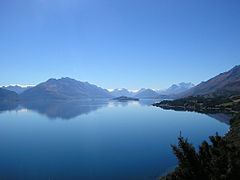Basin countries New Zealand Area 291 km² Length 80 km | Primary inflows Catchment area 2,674 km (1,032 sq mi) Max depth 380 m Surface elevation 310 m | |
 | ||
Similar The Remarkables, Milford Sound, Lake Wanaka, Coronet Peak, Shotover River | ||
Lake Wakatipu is an inland lake (finger lake) in the South Island of New Zealand. It is in the southwest corner of the Otago region, near its boundary with Southland. Lake Wakatipu comes from the original Māori word Whakatipu wai-māori.
Contents
Map of Lake Wakatipu, Otago, New Zealand
With a length of 80 kilometres (50 mi), it is New Zealand's longest lake, and, at 291 km2 (112 sq mi), its third largest. The lake is also very deep, its floor being below sea level, with a maximum depth of 380 metres (1,250 ft). It is at an altitude of 310 metres (1,020 ft), towards the southern end of the Southern Alps. The general topography is a reversed "N" shape or "dog leg". The Dart River flows into the northern end, the lake then runs south for 30 kilometres before turning abruptly to the east. Twenty kilometres (12.4 mi) further along, it turns sharply to the south, reaching its southern end 30 kilometres (19 mi) further south, near Kingston.
The lake is drained by the Kawarau River, which flows out from the lake's Frankton Arm, 8 km (5.0 mi) east of Queenstown. Until about 18,000 years ago the Mataura River drained Lake Wakatipu. The Kingston Flyer follows part of the former river bed now blocked by glacial moraine . Queenstown is on the northern shore of the lake close to eastern end of its middle section. It has a seiche of period 26.7 minutes which, in Queenstown Bay, causes the water level to rise and fall some 200 millimetres (7.9 in).
Lake Wakatipu is renowned for its scenic beauty, being surrounded by mountains. The Remarkables mountain range lies along its southeastern edge. It is a popular venue for adventure tourism, with skifields, paragliding, bungy jumping and tramping tracks within easy reach. A vintage steamboat, the TSS Earnslaw regularly plies its waters. Several vineyards are nearby in the Gibbston Valley.
Etymology
The original form and meaning of the name are not known for certain. The name is believed to originate from the Waitaha people, who were later displaced by Kāti Mamoe. Taken literally, Wakatipu would mean "growing canoe" or possibly "growing bay" if the original was Whakatipu and the h elided as a result of the Southern Māori dialect. The dialect is also known for dropping final vowels, and Wakatipua or Whakatipua (Canoe/Bay of spirits) have also been recorded historically, as has Wakatapu (sacred vessel). A legend says that the lake bed was formed when a giant ogre, Kopu-wai was burned while lying asleep. Waka can also mean 'hollow'.
Wildlife
Lake Wakatipu is a habitat for the longfin eel (a specimen caught in 1886 is the largest known of this species), brown trout, salmon and rainbow trout. These and other fish support predators such as the pied shag. The black-billed gull is often found around the lake while the most common birds are the black-billed gull and the introduced mallard. A smaller bird often not noticed because of its size is the New Zealand scaup.
Film
Lake Wakatipu has many geographical similarities to Loch Ness. Therefore, it doubled as the famous Scottish Loch Ness in the film The Water Horse: Legend of the Deep (2007) and was one of the main filming locations in the movie.
